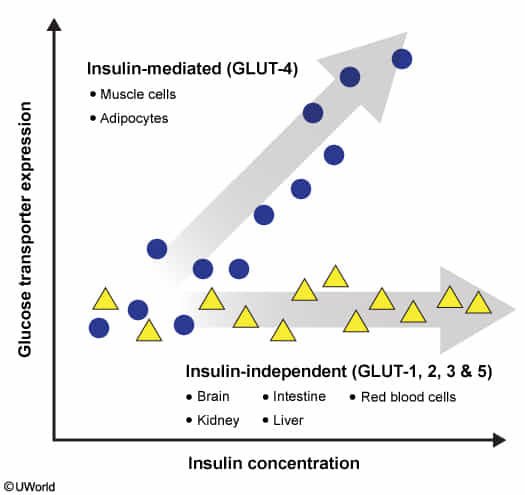Glucose enters intestinal epithelial cells and proximal renal tubular cells via SGLT. In all other cells of the body, glucose uptake occurs via specific membranous glucose transporters (e.g., GLUT2, GLUT5).
Sodium-dependent glucose cotransporter (SGLT)
- Intestinal glucose absorption: via SGLT1
- Secondary active transport: The driving force of absorption is a sodium concentration gradient maintained by basal Na+/K+ ATPase, which transports sodium out of the cell.
- Sodium moves down its concentration gradient into the cell, taking a glucose molecule with it each time.
- Renal glucose reabsorption
- Free filtration of glucose by the kidneys
- Complete reabsorption (urine normally is glucose-free) in the proximal tubules via two types of SGLT
- A membrane protein that mediates glucose and sodium transport across apical cell membranes in the small intestine and kidneys.
- Utilizes the energy provided by the sodium gradient across the cell membrane for active glucose transport.
- SGLT1
- Reabsorbs the remaining glucose (∼ 2%) as well as galactose in the PCT
- One molecule of glucose is absorbed together with two molecules of sodium
- SGLT2
- Reabsorbs ∼ 98% of urinary glucose in the proximal convoluted tubule (PCT)
- One molecule of glucose is absorbed together with one molecule of sodium.
- Reabsorption also relies on a sodium concentration gradient via Na+/K+ ATPase.
Glucose transporters (GLUTs)
- GLUT-1 contributes to basal glucose transport in erythrocytes and at the blood-brain barrier.
- GLUT-2 is present in hepatocytes, pancreatic beta cells, and at the basolateral membrane of renal tubules and small intestinal mucosa. It plays a role in absorption of dietary glucose, reabsorption of glucose from renal tubules, hepatic glucose regulation, and sensitivity of beta cells to circulating glucose.
- GLUT-3 is involved in placental and neuronal glucose transport.
- GLUT-4 is present in adipose tissue, and skeletal & heart muscle
- Only one responsive to insulin
- Plays a key role in regulating body glucose homeostasis
- Insulin stimulates incorporation of GLUT4 (stored in vesicles) into plasma membranes of cells for controlled glucose uptake and storage.
- Physical exercise also induces the translocation of GLUT4 into the plasma membrane of skeletal muscle, in an insulin-independent manner.

- GLUT-5 is a fructose transporter found in spermatocytes and the gastrointestinal tract.